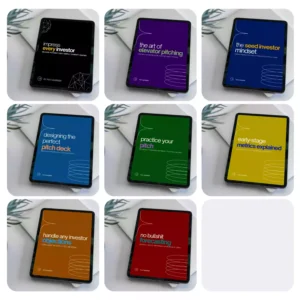TL;DR
Typography significantly influences the visual hierarchy in pitch decks by controlling the size, weight, and placement of text elements. This helps create a structured, readable, and visually appealing presentation that effectively guides the audience through key information.
Understanding Visual Hierarchy in Pitch Decks
Creating an effective pitch deck requires more than just listing information; it involves telling a compelling story visually. A crucial aspect of this visual storytelling is establishing a clear visual hierarchy. Visual hierarchy refers to the arrangement of elements in a way that implies importance. When done right, it helps your audience quickly understand what information is most critical.
Typography plays a significant role in establishing this hierarchy. By manipulating font size, weight, and arrangement, you can guide your audience’s eyes along the most important elements of your presentation. For example, larger fonts for headings and subheadings naturally command more attention than smaller body text.
This increased readability helps maintain audience engagement, ensuring they follow along without getting lost. Moreover, a thoughtful visual hierarchy makes your pitch deck look more professional and well-organized, which can leave a lasting impression on potential investors or stakeholders.
Font Size and Importance
The size of your font sets the stage for understanding the importance of different text elements. In pitch decks, key points should be easily identifiable at a glance. Using larger fonts for headings and subheadings distinguishes them from body text, making it easier for your audience to discern the main points.
As a general rule of thumb, titles might be set at around 24pt, subheadings around 18pt, and body text around 12pt. These differences in size make it apparent what’s primary information and what’s supplementary. Without this hierarchy, your text might seem jumbled, making it hard for your audience to grasp your key messages quickly.
Take, for example, a slide summarizing your business idea. The title “Our Business Idea” might be in 24pt, the subheading “The Problem We Solve” in 18pt, and the detailed explanation in 12pt. This structure ensures that the key points stand out immediately, and detailed information is there but doesn’t overshadow the headline points.
Using Weight to Emphasize Key Points
Weight refers to the boldness of the type. While font size indicates importance, the weight can emphasize it further. Bold text is more eye-catching and is usually interpreted as more important. For instance, using bold for essential statistics or crucial terminologies can make those elements stand out within blocks of text.
This technique can break up large chunks of text, making them more digestible. Suppose you have a list of features in your product pitch. By bolding the most significant features, you ensure that even skimming readers catch the main highlights.
However, overusing bold or heavy fonts can lead to an overwhelming design. It’s essential to use this tool sparingly and strategically to maintain its effectiveness.
Alignment and Layout Choices
How text is aligned within your pitch deck influences its readability and aesthetic. Common text alignments include left-aligned, centered, or justified text. Each alignment has its strengths and weaknesses in contribution to visual hierarchy.
Left-aligned text is often the easiest to read, especially for larger blocks of text. This alignment allows the audience’s eyes to naturally flow from one line to the next without much effort. Center-aligned text works well for titles and short headers, creating a balanced and centered feel. Justified text can make columns of text appear neat, but it may sometimes introduce odd spacing that disrupts readability.
Additionally, layout choices such as margin sizes and spacing between elements also impact how information is perceived. Consistent spacing and margins can lead to a clean, organized look, which supports a strong visual hierarchy.
For instance, aligning your text to the left with enough spacing between points creates an orderly flow. On the other hand, centering key quotes or statements in the middle of a slide can draw attention to them, emphasizing their importance.
Typeface Pairing: A Balancing Act
Choosing the right typefaces for your pitch deck is equally important. The combination of different typefaces – one for headings and another for body text – can help strengthen your visual hierarchy. Sans-serif fonts are modern and clean, making them suitable for headlines and titles. Serif fonts, which are more traditional, work well for body text because they are easier to read in longer paragraphs.
For example, pairing Arial for headings with Times New Roman for body text creates a clear distinction between different levels of information. This pairing not only aids in readability but also adds a layer of sophistication to your presentation.
While pairing fonts, it’s crucial to maintain consistency. Too many typefaces can make a pitch deck appear cluttered, detracting from the information you’re trying to convey. Stick to two or three typefaces to keep the deck cohesive and readable.
Questions to Consider
- Have you used font sizes effectively to highlight the most important information in your pitch deck?
- Are the key points in your presentation emphasized with bold or heavier fonts where necessary?
- Is your text alignments contributing to an easily readable and visually appealing presentation?
- Have you paired typefaces appropriately to create a clear distinction between headings and body text?
- Is your pitch deck visually cohesive without being cluttered with too many different fonts?
Your Next Steps
Invest time in reviewing and potentially redesigning the typography in your pitch deck. Focus on creating a visual hierarchy that guides your audience through your presentation smoothly and effectively. Remember, your goal is to make key points stand out while ensuring that supplementary information is also easily accessible.
Consider using a consistent format for font sizes, weights, alignments, and typeface pairings. These efforts will pay off by making your pitch deck not only more engaging but also more persuasive.
Take the time to review your current pitch deck and identify areas where the visual hierarchy could be improved through typography. Small changes can make a significant impact.





